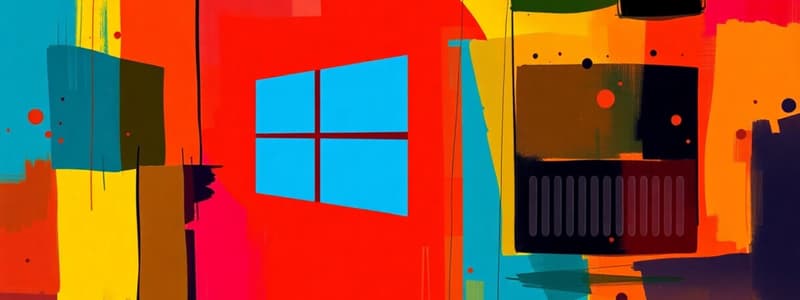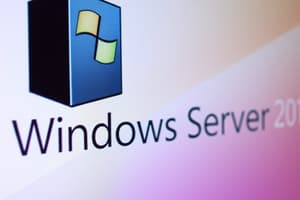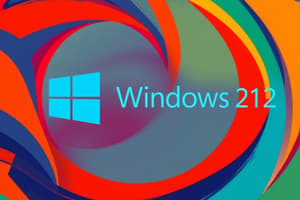Podcast
Questions and Answers
Which edition of Windows Server 2012/R2 allows for an unlimited number of virtual instances?
Which edition of Windows Server 2012/R2 allows for an unlimited number of virtual instances?
- Essential Edition
- Foundation Edition
- Datacenter Edition (correct)
- Standard Edition
The Standard Edition of Windows Server 2012/R2 supports an unlimited number of virtual instances.
The Standard Edition of Windows Server 2012/R2 supports an unlimited number of virtual instances.
False (B)
What is the maximum amount of RAM supported by Datacenter and Standard editions?
What is the maximum amount of RAM supported by Datacenter and Standard editions?
4 TB
The _____ Edition is targeted at small businesses with 25 or fewer users.
The _____ Edition is targeted at small businesses with 25 or fewer users.
Match the following Windows Server editions with their features:
Match the following Windows Server editions with their features:
Which edition does NOT require Client Access Licenses (CALs)?
Which edition does NOT require Client Access Licenses (CALs)?
Virtualization allows multiple operating systems to run on the same physical server simultaneously.
Virtualization allows multiple operating systems to run on the same physical server simultaneously.
What is the role of the host computer in virtualization?
What is the role of the host computer in virtualization?
The _____ Edition of Windows Server does not support Hyper-V.
The _____ Edition of Windows Server does not support Hyper-V.
Match the following software associated with virtualization:
Match the following software associated with virtualization:
What is the maximum number of users supported by the Foundation Edition?
What is the maximum number of users supported by the Foundation Edition?
The Standard Edition of Windows Server 2012/R2 allows for an unlimited number of virtual instances.
The Standard Edition of Windows Server 2012/R2 allows for an unlimited number of virtual instances.
What mode is set as the default installation option for both Datacenter and Standard editions?
What mode is set as the default installation option for both Datacenter and Standard editions?
The ______ Edition is automatically configured as a root domain controller.
The ______ Edition is automatically configured as a root domain controller.
Match the following Windows Server editions with their primary characteristics:
Match the following Windows Server editions with their primary characteristics:
Which feature is NOT supported by the Foundation Edition?
Which feature is NOT supported by the Foundation Edition?
Both Datacenter and Standard editions require Client Access Licenses (CALs).
Both Datacenter and Standard editions require Client Access Licenses (CALs).
What essential technology allows for the emulation of multiple hardware environments?
What essential technology allows for the emulation of multiple hardware environments?
A virtual machine (VM) emulates a physical computer’s hardware and ______.
A virtual machine (VM) emulates a physical computer’s hardware and ______.
What is the maximum amount of RAM supported by Datacenter and Standard editions?
What is the maximum amount of RAM supported by Datacenter and Standard editions?
What is the primary audience for the Essential Edition of Windows Server 2012/R2?
What is the primary audience for the Essential Edition of Windows Server 2012/R2?
The Foundation Edition of Windows Server 2012/R2 supports Hyper-V.
The Foundation Edition of Windows Server 2012/R2 supports Hyper-V.
How many physical processors does the Foundation Edition support?
How many physical processors does the Foundation Edition support?
Both Datacenter and Standard editions support up to ______ physical processors.
Both Datacenter and Standard editions support up to ______ physical processors.
Match the following Windows Server editions with their key features:
Match the following Windows Server editions with their key features:
What mode is the default installation option for both Datacenter and Standard editions?
What mode is the default installation option for both Datacenter and Standard editions?
Client Access Licenses (CALs) are not required for the Essential Edition.
Client Access Licenses (CALs) are not required for the Essential Edition.
What is the maximum RAM supported by the Standard and Datacenter editions?
What is the maximum RAM supported by the Standard and Datacenter editions?
A _______ is a virtual environment that emulates a physical computer's hardware.
A _______ is a virtual environment that emulates a physical computer's hardware.
Which edition of Windows Server 2012/R2 is available only as an OEM version?
Which edition of Windows Server 2012/R2 is available only as an OEM version?
Flashcards are hidden until you start studying
Study Notes
Windows Server 2012/R2 Editions
- Five editions available: Datacenter, Standard, Essential, Foundation, and the streamlined approach compared to Windows Server 2008.
- Businesses can select the edition that aligns with their size and service needs.
Datacenter Edition
- Allows unlimited virtual instances of the operating system with Hyper-V installed on a physical server.
- Requires one license for every two physical processors on the server.
Standard Edition
- Includes all features of Datacenter Edition with identical processor licensing conditions.
- Permits only two virtual instances.
Common Features of Datacenter and Standard Editions
- Support for up to 4 TB of RAM and 64 physical processors.
- Can form server clusters consisting of up to 64 nodes.
- Can be installed in Server Core mode, which is the default installation without a graphical user interface (GUI).
- Both editions necessitate Client Access Licenses (CALs) for each user logging onto the server.
Essential Edition
- Tailored for small businesses with a maximum of 25 users.
- Automatically configured as a root domain controller with services like Active Directory, DNS, and Web Server (IIS).
- Managed through a user-friendly Dashboard interface.
- Does not require CALs.
Foundation Edition
- Entry-level edition intended for small businesses.
- Available only as an Original Equipment Manufacturer (OEM) version.
- Licensing limits usage to 15 users and does not require CALs.
- Supports a single physical processor and up to 32 GB of RAM.
- Can serve as a stand-alone server or a root domain controller but does not support Hyper-V.
Cloud Computing and Virtualization
- Cloud computing encompasses technologies that abstract resources like applications, storage, and networks for users.
- Virtualization is central to cloud computing, allowing multiple operating systems to run on one physical server via emulation.
- A virtual machine (VM) simulates a physical computer’s hardware and BIOS.
- The host computer is the physical server running VM software and VMs.
- Virtualization software manages VM creation and the virtual environment.
- A hypervisor is the core component of virtualization software that creates and monitors virtual hardware environments.
Types of Cloud Services
- Public Cloud: Services offered by third-party providers (e.g., DropBox, SkyDrive, Google Apps).
- Private Cloud: Internal IT department-managed services typically including virtual desktops, storage, and applications.
- Virtual Desktop Infrastructure (VDI) allows users to access desktops over the internet via browsers or client software.
Windows Server 2012/R2 Editions
- Five editions available: Datacenter, Standard, Essential, Foundation, and the streamlined approach compared to Windows Server 2008.
- Businesses can select the edition that aligns with their size and service needs.
Datacenter Edition
- Allows unlimited virtual instances of the operating system with Hyper-V installed on a physical server.
- Requires one license for every two physical processors on the server.
Standard Edition
- Includes all features of Datacenter Edition with identical processor licensing conditions.
- Permits only two virtual instances.
Common Features of Datacenter and Standard Editions
- Support for up to 4 TB of RAM and 64 physical processors.
- Can form server clusters consisting of up to 64 nodes.
- Can be installed in Server Core mode, which is the default installation without a graphical user interface (GUI).
- Both editions necessitate Client Access Licenses (CALs) for each user logging onto the server.
Essential Edition
- Tailored for small businesses with a maximum of 25 users.
- Automatically configured as a root domain controller with services like Active Directory, DNS, and Web Server (IIS).
- Managed through a user-friendly Dashboard interface.
- Does not require CALs.
Foundation Edition
- Entry-level edition intended for small businesses.
- Available only as an Original Equipment Manufacturer (OEM) version.
- Licensing limits usage to 15 users and does not require CALs.
- Supports a single physical processor and up to 32 GB of RAM.
- Can serve as a stand-alone server or a root domain controller but does not support Hyper-V.
Cloud Computing and Virtualization
- Cloud computing encompasses technologies that abstract resources like applications, storage, and networks for users.
- Virtualization is central to cloud computing, allowing multiple operating systems to run on one physical server via emulation.
- A virtual machine (VM) simulates a physical computer’s hardware and BIOS.
- The host computer is the physical server running VM software and VMs.
- Virtualization software manages VM creation and the virtual environment.
- A hypervisor is the core component of virtualization software that creates and monitors virtual hardware environments.
Types of Cloud Services
- Public Cloud: Services offered by third-party providers (e.g., DropBox, SkyDrive, Google Apps).
- Private Cloud: Internal IT department-managed services typically including virtual desktops, storage, and applications.
- Virtual Desktop Infrastructure (VDI) allows users to access desktops over the internet via browsers or client software.
Windows Server 2012/R2 Editions
- Five editions available: Datacenter, Standard, Essential, Foundation, and the streamlined approach compared to Windows Server 2008.
- Businesses can select the edition that aligns with their size and service needs.
Datacenter Edition
- Allows unlimited virtual instances of the operating system with Hyper-V installed on a physical server.
- Requires one license for every two physical processors on the server.
Standard Edition
- Includes all features of Datacenter Edition with identical processor licensing conditions.
- Permits only two virtual instances.
Common Features of Datacenter and Standard Editions
- Support for up to 4 TB of RAM and 64 physical processors.
- Can form server clusters consisting of up to 64 nodes.
- Can be installed in Server Core mode, which is the default installation without a graphical user interface (GUI).
- Both editions necessitate Client Access Licenses (CALs) for each user logging onto the server.
Essential Edition
- Tailored for small businesses with a maximum of 25 users.
- Automatically configured as a root domain controller with services like Active Directory, DNS, and Web Server (IIS).
- Managed through a user-friendly Dashboard interface.
- Does not require CALs.
Foundation Edition
- Entry-level edition intended for small businesses.
- Available only as an Original Equipment Manufacturer (OEM) version.
- Licensing limits usage to 15 users and does not require CALs.
- Supports a single physical processor and up to 32 GB of RAM.
- Can serve as a stand-alone server or a root domain controller but does not support Hyper-V.
Cloud Computing and Virtualization
- Cloud computing encompasses technologies that abstract resources like applications, storage, and networks for users.
- Virtualization is central to cloud computing, allowing multiple operating systems to run on one physical server via emulation.
- A virtual machine (VM) simulates a physical computer’s hardware and BIOS.
- The host computer is the physical server running VM software and VMs.
- Virtualization software manages VM creation and the virtual environment.
- A hypervisor is the core component of virtualization software that creates and monitors virtual hardware environments.
Types of Cloud Services
- Public Cloud: Services offered by third-party providers (e.g., DropBox, SkyDrive, Google Apps).
- Private Cloud: Internal IT department-managed services typically including virtual desktops, storage, and applications.
- Virtual Desktop Infrastructure (VDI) allows users to access desktops over the internet via browsers or client software.
Studying That Suits You
Use AI to generate personalized quizzes and flashcards to suit your learning preferences.




